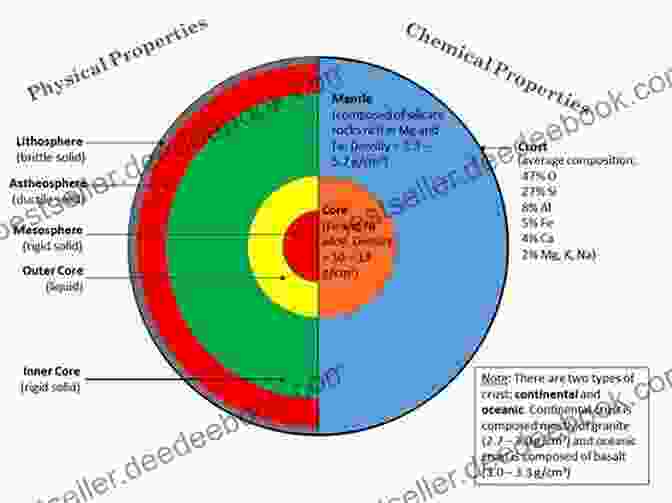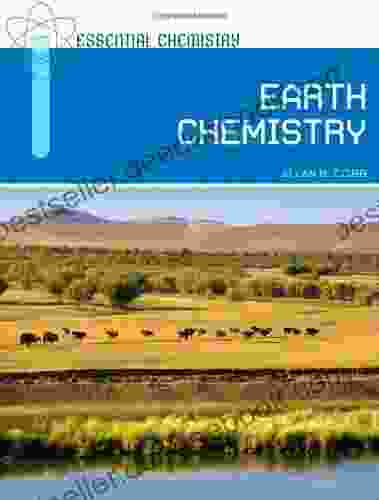Essential Chemistry - Earth Chemistry by Allan Cobb

4.4 out of 5
| Language | : | English |
| File size | : | 4052 KB |
| Text-to-Speech | : | Enabled |
| Screen Reader | : | Supported |
| Word Wise | : | Enabled |
| Print length | : | 130 pages |
Essential Chemistry - Earth Chemistry by Allan Cobb is an indispensable resource for anyone interested in the chemical processes that shape our planet. This comprehensive and engaging text provides a thorough understanding of the chemical composition of the Earth, including its rocks, minerals, water, and air. Allan Cobb's clear and accessible writing style makes this an excellent resource for students, researchers, and anyone interested in the field of geochemistry.
The book begins with an overview of the basic principles of chemistry, including the structure of atoms, the periodic table, and chemical bonding. Cobb then discusses the chemical composition of the Earth's crust, mantle, and core. He also covers the chemical processes that occur at the Earth's surface, including weathering, erosion, and the formation of sedimentary rocks. The book concludes with a discussion of the chemical cycles that regulate the Earth's atmosphere, hydrosphere, and biosphere.
The Chemical Composition of the Earth
The Earth is composed of a variety of elements, the most abundant of which are iron, oxygen, silicon, and magnesium. These elements are arranged into a series of concentric layers, with the core being the densest and the atmosphere being the least dense. The chemical composition of each layer varies, reflecting the different temperatures and pressures that exist at different depths.
The Earth's crust is the outermost layer of the planet and is composed primarily of igneous rocks. Igneous rocks are formed when molten rock cools and solidifies. The composition of igneous rocks varies depending on the minerals that are present in the molten rock. The most common minerals in igneous rocks are feldspar, quartz, and mica.
The Earth's mantle is the layer of the planet that lies beneath the crust. The mantle is composed primarily of peridotite, a rock that is rich in magnesium and iron. The mantle is much hotter than the crust and is under great pressure. The high temperatures and pressures in the mantle cause the rocks to flow slowly, which is responsible for the movement of the Earth's tectonic plates.
The Earth's core is the innermost layer of the planet and is composed primarily of iron and nickel. The core is very hot and is under immense pressure. The high temperatures and pressures in the core cause the iron and nickel to melt and form a liquid outer core. The inner core is solid and is composed primarily of iron.
The Chemical Processes that Occur at the Earth's Surface
The chemical processes that occur at the Earth's surface are responsible for the formation of sedimentary rocks, the weathering of rocks, and the erosion of landforms. Sedimentary rocks are formed when sediments, such as sand, silt, and clay, are deposited and compacted over time. Sedimentary rocks can be classified based on the size of the sediments that they contain. The weathering of rocks is the process by which rocks are broken down into smaller pieces by the action of water, wind, and ice. Erosion is the process by which weathered rocks are transported from one place to another by the action of water, wind, and ice.
The chemical processes that occur at the Earth's surface also play a role in the regulation of the Earth's climate. The atmosphere is composed primarily of nitrogen, oxygen, and argon. The atmosphere also contains small amounts of carbon dioxide, water vapor, and other gases. The concentration of carbon dioxide in the atmosphere is regulated by the process of photosynthesis, which is carried out by plants and other organisms. Photosynthesis removes carbon dioxide from the atmosphere and converts it into organic matter. The organic matter is then stored in plants and other organisms or is released into the atmosphere as carbon dioxide when the organisms die.
The Chemical Cycles that Regulate the Earth's Atmosphere, Hydrosphere, and Biosphere
The chemical cycles that regulate the Earth's atmosphere, hydrosphere, and biosphere are essential for the maintenance of life on Earth. The carbon cycle is the process by which carbon is exchanged between the atmosphere, the hydrosphere, and the biosphere. The nitrogen cycle is the process by which nitrogen is exchanged between the atmosphere, the hydrosphere, and the biosphere. The water cycle is the process by which water is exchanged between the atmosphere, the hydrosphere, and the biosphere.
The carbon cycle is essential for the regulation of the Earth's climate. Carbon dioxide is a greenhouse gas, which means that it traps heat in the atmosphere. The concentration of carbon dioxide in the atmosphere is regulated by the process of photosynthesis, which removes carbon dioxide from the atmosphere and converts it into organic matter. The organic matter is then stored in plants and other organisms or is released into the atmosphere as carbon dioxide when the organisms die.
The nitrogen cycle is essential for the growth of plants. Nitrogen is a vital nutrient for plants and is used to make proteins, chlorophyll, and other essential compounds. The nitrogen cycle is the process by which nitrogen is exchanged between the atmosphere, the hydrosphere, and the biosphere. Nitrogen is fixed from the atmosphere by bacteria and other organisms and is then converted into a form that can be used by plants. The nitrogen is then passed up the food chain as plants are eaten by animals and animals are eaten by other animals.
The water cycle is essential for the maintenance of life on Earth. Water is used by plants for photosynthesis, by animals for drinking and bathing, and by humans for a variety of purposes. The water cycle is the process by which water is exchanged between the atmosphere, the hydrosphere, and the biosphere. Water evaporates from the surface of the Earth and condenses into clouds. The clouds then release the water as rain or snow, which falls to the ground.
Essential Chemistry - Earth Chemistry by Allan Cobb is an indispensable resource for anyone interested in the chemical processes that shape our planet. Cobb provides a thorough and accessible overview of the chemical composition of the Earth, the chemical processes that occur at the Earth's surface, and the chemical cycles that regulate the Earth's atmosphere, hydrosphere, and biosphere.
This book is an excellent resource for students, researchers, and anyone interested in the field of geochemistry.

4.4 out of 5
| Language | : | English |
| File size | : | 4052 KB |
| Text-to-Speech | : | Enabled |
| Screen Reader | : | Supported |
| Word Wise | : | Enabled |
| Print length | : | 130 pages |
Do you want to contribute by writing guest posts on this blog?
Please contact us and send us a resume of previous articles that you have written.
 Novel
Novel Chapter
Chapter Text
Text Reader
Reader Library
Library Paperback
Paperback Magazine
Magazine Bookmark
Bookmark Shelf
Shelf Glossary
Glossary Foreword
Foreword Preface
Preface Codex
Codex Bestseller
Bestseller Classics
Classics Library card
Library card Biography
Biography Memoir
Memoir Reference
Reference Dictionary
Dictionary Thesaurus
Thesaurus Character
Character Resolution
Resolution Card Catalog
Card Catalog Borrowing
Borrowing Stacks
Stacks Archives
Archives Study
Study Scholarly
Scholarly Lending
Lending Reserve
Reserve Academic
Academic Reading Room
Reading Room Special Collections
Special Collections Literacy
Literacy Thesis
Thesis Storytelling
Storytelling Awards
Awards Book Club
Book Club Textbooks
Textbooks Chloe Langr
Chloe Langr Allan B Cobb
Allan B Cobb Maia Ross
Maia Ross Linda Reilly
Linda Reilly Mccaffrey Winner
Mccaffrey Winner Philip Wilkinson
Philip Wilkinson Amelia Rose
Amelia Rose Dr Morgan L Jones
Dr Morgan L Jones Millard Crow
Millard Crow Evelyn Hughes
Evelyn Hughes Alison Peirse
Alison Peirse Michael C Dawson
Michael C Dawson Xiaoquan Kong
Xiaoquan Kong Winfried Lamersdorf
Winfried Lamersdorf Leigh Selfman
Leigh Selfman Kristin Hannah
Kristin Hannah Henry Lyra
Henry Lyra Andrey Kurkov
Andrey Kurkov Lynda Rutledge
Lynda Rutledge Ellie Cummins
Ellie Cummins
Light bulbAdvertise smarter! Our strategic ad space ensures maximum exposure. Reserve your spot today!

 Hunter MitchellFalse Starts, Beautiful Disasters, Public Humiliations, and Other Secrets to...
Hunter MitchellFalse Starts, Beautiful Disasters, Public Humiliations, and Other Secrets to...
 Donald WardExperience the Enchanting Beauty of Japan: A Photographic Journey from Tokyo...
Donald WardExperience the Enchanting Beauty of Japan: A Photographic Journey from Tokyo... Finn CoxFollow ·9.2k
Finn CoxFollow ·9.2k Anton FosterFollow ·10.8k
Anton FosterFollow ·10.8k Fyodor DostoevskyFollow ·13.3k
Fyodor DostoevskyFollow ·13.3k Dylan MitchellFollow ·10.1k
Dylan MitchellFollow ·10.1k Colin RichardsonFollow ·2.9k
Colin RichardsonFollow ·2.9k Bob CooperFollow ·3.5k
Bob CooperFollow ·3.5k Jimmy ButlerFollow ·12.6k
Jimmy ButlerFollow ·12.6k Jeffrey CoxFollow ·16.2k
Jeffrey CoxFollow ·16.2k

 Brian Bell
Brian BellClassic Festival Solos Bassoon Volume Piano...
The Classic Festival Solos Bassoon Volume...

 Aubrey Blair
Aubrey BlairUnveiling the Courage: Insurgent Women Female Combatants...
In the face of armed...

 Jan Mitchell
Jan MitchellFor The Liberty Of Texas: The Lone Star State's Fight for...
The Republic of Texas was a sovereign state...

 Edgar Allan Poe
Edgar Allan PoeVisible, Explainable, Trustworthy, and Transparent...
What is VET2...
4.4 out of 5
| Language | : | English |
| File size | : | 4052 KB |
| Text-to-Speech | : | Enabled |
| Screen Reader | : | Supported |
| Word Wise | : | Enabled |
| Print length | : | 130 pages |












